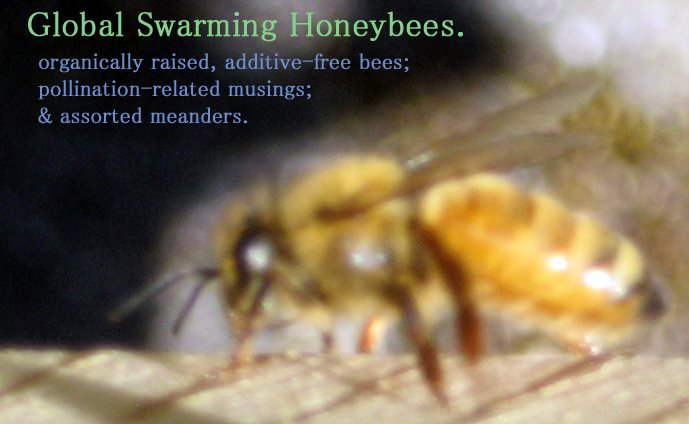We all turned our gaze to where he motioned.
 Yes, it was a swarm in the tree! Actually, an afterswarm. Whereby a colony, having already "thrown a swarm" in which some bees depart with the old queen while others stay in the hive with new queen cells decide, once those queens hatch, to create smaller swarms with the new queens leading the excursions. (Confused yet? Don't even try to keep up with the bees; they are much more complicated than we can possibly fathom.)
Yes, it was a swarm in the tree! Actually, an afterswarm. Whereby a colony, having already "thrown a swarm" in which some bees depart with the old queen while others stay in the hive with new queen cells decide, once those queens hatch, to create smaller swarms with the new queens leading the excursions. (Confused yet? Don't even try to keep up with the bees; they are much more complicated than we can possibly fathom.)My guests felt they'd gotten more than they'd bargained for (in a good way). I was baffled. I was intrigued. I was also, to paraphrase Vladmir in Waiting for Godot, growing weary of this motif. It was hard not to take this afterswarm personally; were the bees so disgruntled with my beekeeping skills that they were going to afterswarm themselves until the hives were empty?
I also found, to my surprise, that swarm catching is a rather addictive pursuit. Once again, the bees were temptingly located on a low branch—why not take them? But no, I fought the urge; I'd had enough drama for one summer. I decided to let the free-spirited bees go their way in the world—may fortune smile upon them.
I did enjoy watching the swarm cluster alter its shape over the next day or two, in response to warmth, cooler weather, and mild rains.


Two days later, a second afterswarm appeared in another sumac at the edge of the bee yard. This time, I was fortunate enough to see the bees swarming in the air—a deeply energizing sight—and form a small cluster on a very low branch.
 By now, swarming was becoming a way of life around here. Each day, I wandered to the bee yard a few times to check on both swarms. The second, smaller afterswarm disappeared after two days; the first afterswarm continued to hang around, tempting me with its presence.
By now, swarming was becoming a way of life around here. Each day, I wandered to the bee yard a few times to check on both swarms. The second, smaller afterswarm disappeared after two days; the first afterswarm continued to hang around, tempting me with its presence.Slowly, inexorably, the idea of capturing this afterswarm gained traction. Several factors contributed to my succombing to the siren call:
(1) I was becoming hopelessly addicted to swarm catching. Is there a 12 Step Program for this sort of thing? (We admitted we were powerless over the swarm....We came to believe the bees could restore us to sanity...etc., etc.)
(2) We were due for very severe weather in the form of Biblical hailstones the next day.
(3) The swarm had stayed put for more than four days, leading me to wonder if there was a shortage of affordable honeybee real estate nearby or if the group simply lacked the necessary get up and go to make it on their own.
(4) Most importantly of all, Rebel Rebel was looking a little undernourished, bee-wise, and I was beginning to suspect that I'd failed to get the queen in during the multi-part hiving process or that part of the colony had left with many bees, or both. With no queen, Rebel Rebel was doomed. With a shortage of workers, the colony was endangered. I knew there was a queen in the afterswarm cluster and the idea of adding this queen along with a pool of workers began to seem like a bright idea that just grew brighter—until it became a blinding force.
 Compare this paltry action at the threshold of Rebel Rebel to the pictures of the boisterous colony in its first few days, as shown in the preceding posts.
Compare this paltry action at the threshold of Rebel Rebel to the pictures of the boisterous colony in its first few days, as shown in the preceding posts.For the second time in as many weeks, a hapless weekend guest was enlisted to help with the hiving. My partner, Lauren—who'd missed out on the original swarming and swarm catching, much to her dismay—was also here, and the three of us were up at 5 the next morning to catch the swarm and combine it with Rebel Rebel.
The hiving was the polar opposite of my previous experience. It was calm, quiet and utterly peaceful. The entire afterswarm was transferred (by our guest—perhaps this is why it went so smoothly) on its branch directly into Rebel Rebel. Not a single bee was dropped, lost, harassed, or traumatized. We closed up the hive and left the two groups in Rebel Rebel to get to know one another. By late that afternoon, the groups had joined forces, the branch was empty of bees, and the hive appeared to be humming.
Who says country life is boring? Never have I been this overstimulated by my life in the city.

Great post. Fantastic info. The more i read about swarming bees and how it's possible to capture them the more fascinated a become with bee keeping. Who'd have thought it could be that exciting!
ReplyDelete